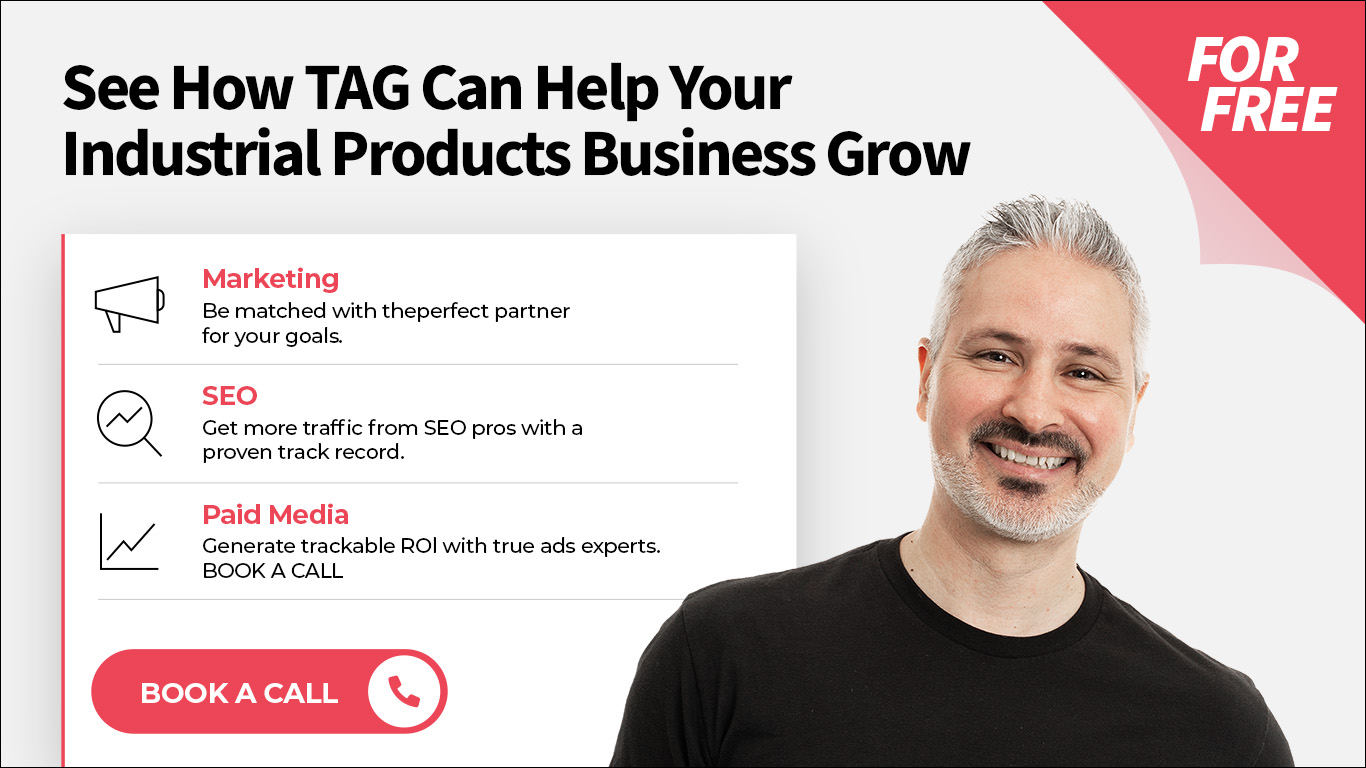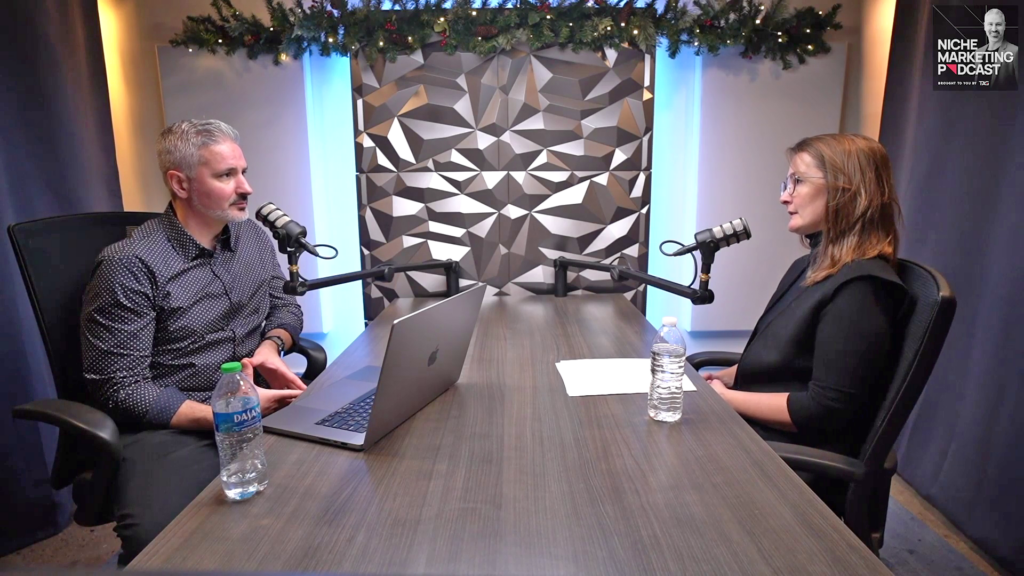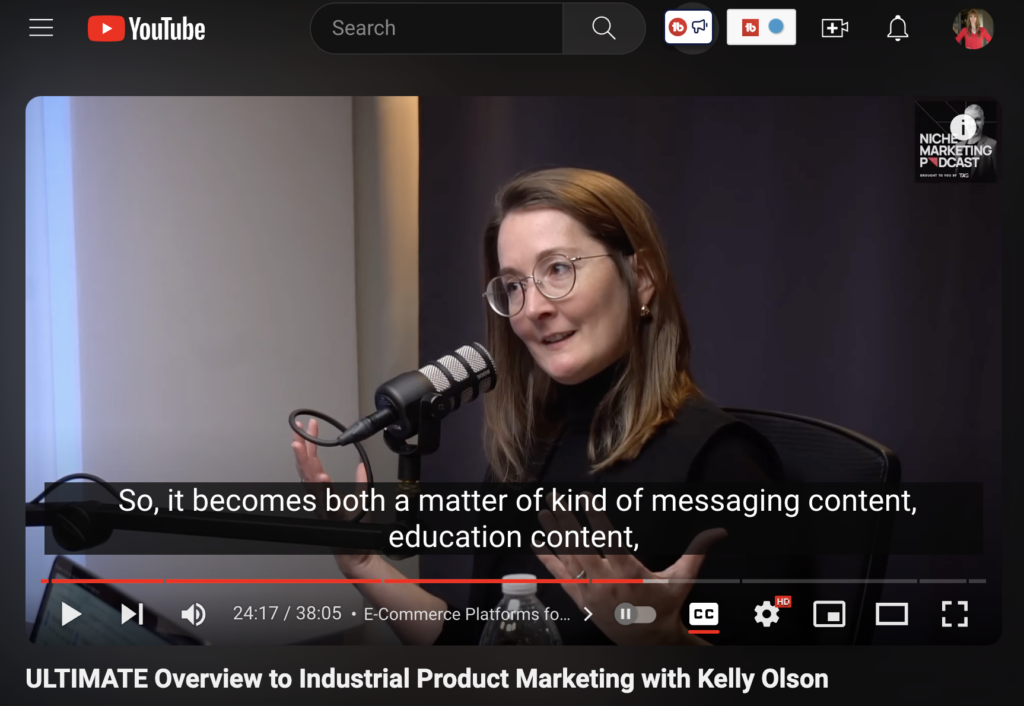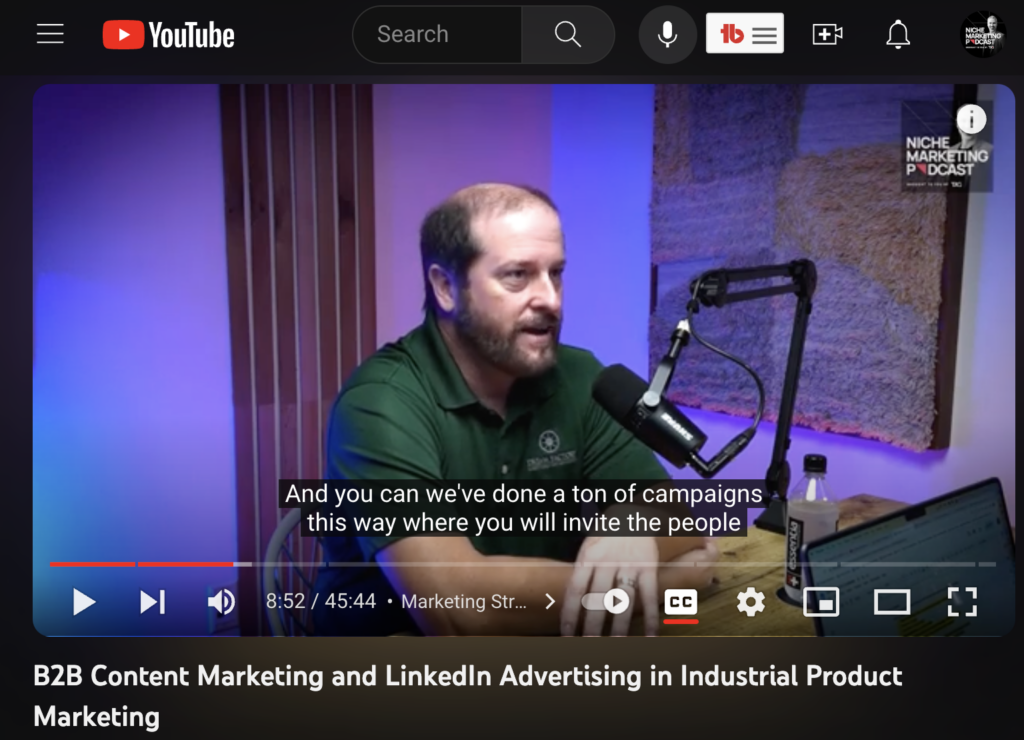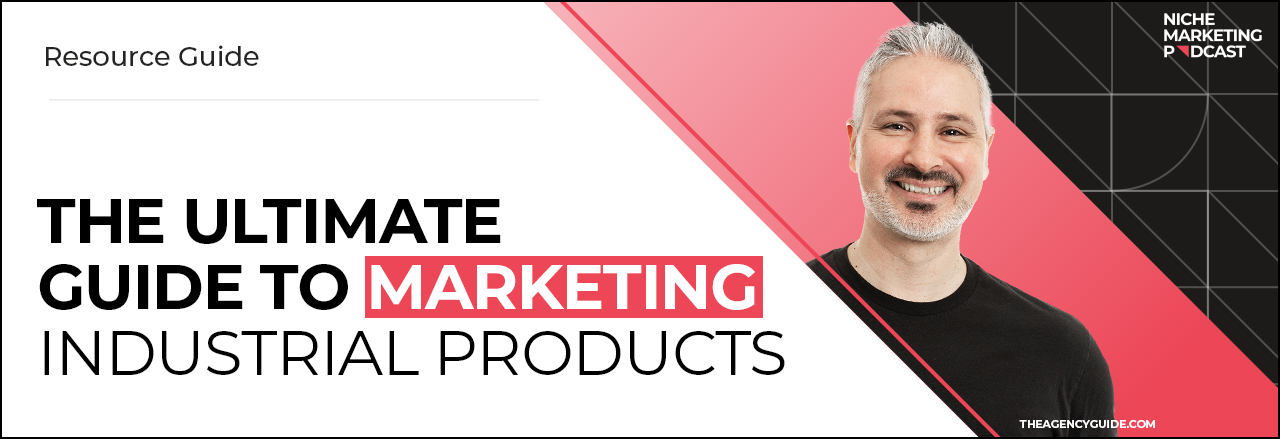
Looking for an in-depth exploration of industrial marketing strategy? You’re in the right place. This comprehensive guide covers every aspect of B2B marketing for industrial products, including:
- Account-Based Marketing
- Chat-Based AI
- Integrated SEO and PPC
- Content Marketing
- B2B LinkedIn Marketing
By the end, you’ll have practical strategies to effectively market and sell more of your industrial products.
Who Should Use This Guide?
We crafted this comprehensive article about industrial product marketing strategy for:
- Business owners in the industrial sector aiming to expand their reach
- Marketing professionals supporting manufacturing or industrial firms
If you want to:
- Understand the terminology and players in the industrial products space
- Learn how marketing is done (well) with industrial products
- Get actionable tips on industrial lead generation and conversion
- Discover the "best practices" for social media, content marketing, email marketing, SEO, paid ads, and more that work for B2B
Then this guide is tailored for you.
Whether you’re new to industrial marketing or looking to refine your current approach, you’ll find insights and strategies to drive growth and outperform your competition.
Five Industrial Supply Industry Expert Interviews
As an agency search firm with pros on staff, we at TAG know marketing. But, to make this guide the most comprehensive resource for industrial professionals, we spoke with five industrial industry product marketing experts and included their best advice throughout the article, too.
For more detailed insights, you can find the full-length interviews featured on the Niche Marketing Podcast in our industrial product marketing series linked here:
- Kelly Olson, Vice President of Strategic Planning at The Mx Group
Industrial Marketing 1: The ULTIMATE Overview to Marketing Industrial Products: Industrial Product Marketing Part 1 - Ross Simmonds, CEO and Founder of Foundation Agency
Industrial Marketing 2: Content Marketing Strategy for Boring Industries: Industrial Product Marketing Part 2 - Thad Kahlow, CEO of BOL
Industrial Marketing 3: Use Account-Based Marketing or FAIL! | Industrial Products Marketing Part 3 - Jim Londeree, COO of Dream Factory
Industrial Marketing 4: B2B Content Marketing and LinkedIn Advertising | Industrial Product Marketing Part 4 - Justin Smith, CEO, Founder & SEO Expert at OuterBox
Industrial Marketing 5: Organic SEO and Paid Search in Industrial Marketing Mastery | Industrial Product Marketing Part 5
The interviews are packed with valuable insights on industrial product marketing strategy and more.
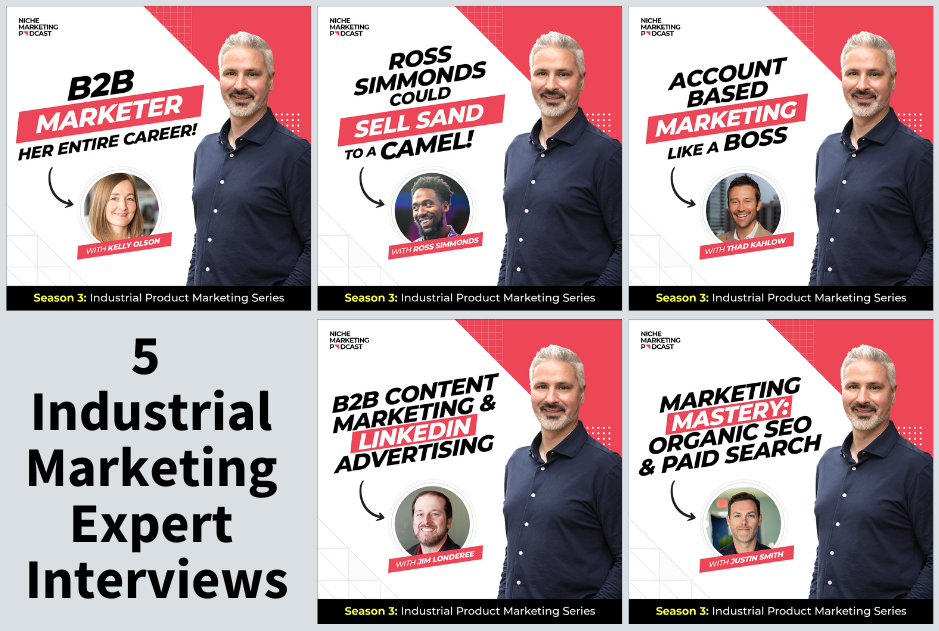
Our Resource Guide Promise
By the end of this guide, you'll have enough knowledge to make sound, informed decisions regarding how to market your industrial products company.
And, if you want bespoke advice, reach out to us at TAG. We matchmake companies pro bono from our pool of vetted marketing agency partners to help you achieve all your marketing and business goals faster.
Okay, now let’s dive in!
Industrial Products Industry Overview
Let's make sure we are on the same page when we use terms in the industrial product space, which is all about the manufacturing, distribution, and sale of products and materials used in industrial production and maintenance.
If you’re new to the industrial products sector, this is a great primer and overview.
If you’re a seasoned professional, skim and scan down to the sections more heavy on advice specifically about how to market your industrial products company.
Industrial Terminology
- B2B (Business-to-Business): Commerce transactions between businesses, such as an industrial manufacturer and a wholesaler. In contrast to business-to-consumer or B2C marketing, businesses often must sell to an entire buying committee, not just one decision-maker.
- ISO (International Organization for Standardization): Organization that develops and publishes standards businesses must follow to ensure the quality, safety, and efficiency of products, services, and systems.
- JIT (Just-In-Time): Production strategy to improve a business's return on investment (ROI) by reducing in-process inventory and carrying costs.
- Lean Manufacturing: Production practice that views expenditure of resources to be wasteful if in any aspect other than the direct manufacturing of goods.
- MRO (Maintenance, Repair, and Operations): Products and services used to keep machinery and industrial equipment functional and working well.
- OEM (Original Equipment Manufacturer): Companies that manufacture products used in other companies' end products.
- RFID (Radio-Frequency Identification): A technology used to wirelessly identify, track, and manage products or assets.
- VMI (Vendor Managed Inventory): When a supplier takes responsibility for maintaining the customer's inventory levels.

Key Players in the Industrial Products Space
Now that we have looked at key terms, let's look at the key industrial players:
- Manufacturers: Convert raw materials into finished goods such as physical products, machinery, components, and industrial equipment.
- Distributors: Intermediary that often buys exclusively from an industrial manufacturer to distribute its products to more retailers and end users.
- Wholesalers: Intermediary buyers that often work with multiple manufacturers to sell goods in smaller quantities to retailers or other businesses. They are often focused on a geographic location.
- Retailers: Sell industrial products directly to end users via physical stores and/or e-commerce platforms. The final link in the supply chain, they offer more convenience and accessibility than an industrial manufacturer can.
- Service Providers: Companies that offer specialized services related to industrial products, such as logistics, procurement, consulting, and maintenance, adding efficiency and effectiveness to the supply chain.
- Specialty Suppliers: Focus on specific product categories or niche industrial markets. May offer unique products, custom solutions, or in-depth knowledge in a particular field or industrial buyer persona.
- 3PL (Third-Party Logistics) Providers: Companies that handle logistics to businesses such as supply chain and/or product information management.
These companies and service providers work together to ensure a smooth flow of industrial products from manufacturers to end user.
Key Audiences in the Industrial Products Space
A savvy marketer in the industrial space recognizes that there are different decision-makers in the process. Marketing efforts must often target multiple groups of people to achieve its goals. Here are a few of the most important ones:
- Procurement Professionals: Source and purchase industrial products and supplies for their organizations. They look for cost-effective and high-quality solutions above all else.
- Engineers and Technical Professionals: Involved in the technical aspects of product selection, application, and implementation. They are often experts in product life cycle and, therefore, can contribute details an industrial marketer could include in a marketing plan.
- Maintenance and Operations Managers: Oversee the maintenance and operational aspects of industrial facilities. They focus on reliability and efficiency of equipment, machinery, and supplies used in daily operations.
- Plant Managers and Operations Directors: Responsible for overall plant or facility operations. They make strategic decisions about equipment, processes, and supply chain management to optimize productivity.
- Logistics and Supply Chain Professionals: Manage the movement of products throughout the supply chain. They focus on logistics optimization, inventory management, and ensuring timely delivery of industrial supplies.
- Safety Managers: Prioritize workplace safety and compliance with regulations. They care most about things like safety features and certifications.
- Purchasing Managers: Oversee the procurement process and vendor relationships. They make decisions based on cost, quality, and supplier reliability and deeply understand product demand.
- Business Owners and Executives: Decision-makers for business marketing and strategic initiatives, including selecting suppliers. They care about the company's profitability and efficiency, so they must have a complete understanding of how the product life cycle fits consumer market demands and how effective the marketing plan is in driving new leads to the sales team.
- Maintenance Technicians and Operators: Involved in the day-to-day operation and maintenance of equipment. They influence product selection based on ease of use, reliability, and maintenance requirements.
- Environmental Health and Safety (EHS) Professionals: Focus on environmental sustainability, health, and safety compliance. They look for eco-friendly and compliant products and practices.
- Finance Professionals: Track and oversee all financial aspects. They assess the cost-effectiveness and financial impact of industrial product investments. They may also set budgets for Google ad spend, product launch campaigns, and other business marketing initiatives.
- R&D (Research and Development): Focus on developing new products and using new technologies to improve the company's product offerings.
Effectively targeting and addressing the needs of these diverse audiences is crucial for success in marketing channel selection and marketing campaign development.
We have found that if you tailor your messaging, content, marketing automation, and overall marketing channel mix to resonate with each audience segment, you will enhance the overall effectiveness of manufacturing marketing strategy.

Trends in the Industrial Product Sector
The industrial products industry is going through some big changes, and there are a few trends leading the way. Marketing management must keep an eye on their potential customer's needs (the business) as well as what's working in consumer marketing (the business's potential client group or end consumer market).
1. Digitalization
Businesses are increasingly moving to online platforms for their supplies and responding more to traditional B2C marketing techniques. They are using smart technologies to make things run smoother and rely on data analytics to stay on top of what's happening and what's working.
2. Resiliency
There is a drive to make supply chains more resilient. This means being able to adapt and keep things going even when there are big disruptions
3. Sustainability
Industrial businesses are becoming more eco-friendly and thinking about sustainability in their supply chain, equipment, and end consumer good manufacturing. Offering industrial and consumer products that are good for the environment is more important than ever. There is a drive to improve with predictive maintenance, advanced robots, and process automation.
4. Collaboration
Partnerships are developing in new ways as each industrial company is working more closely with their suppliers. Technology like remote monitoring is helping them keep an eye on things in real-time. Some are even looking into using blockchain, a kind of secure digital ledger, to make the supply chain more transparent.
5. Training and Retraining
The industry is paying attention to attracting and retaining skilled workers, putting money into training programs or retraining workers to perform different jobs as automation and machines take over repetitive tasks.
---
These five changes show the industry is serious about going digital, being sustainable, and working smarter, all trends to keep in mind to make a marketing campaign more compelling.
What is Industrial Product Marketing?
Given the increasing saturation and competitiveness in the industrial products sector, effective marketing has become crucial for companies looking to stand out, grow, and thrive.
Simply establishing a Google My Business account and relying on brand awareness built in the past won't attract new clients or partnerships, nor will it guarantee a new product launch is a hit. To navigate the modern B2B landscape, it's essential for an industrial marketer to explore a variety of approaches that align with business goals.
Before delving into expert recommendations for the future, let's examine the diverse marketing strategies available for your industrial products marketing mix.
Traditional Industrial Product Marketing Methods
Traditional marketing methods are conventional approaches that companies in the industrial product sector use to generate leads and promote their products and services.
Common traditional marketing methods in the industrial product sector:
- Billboard Advertising: Displaying ads on large outdoor billboards along roads and highways to catch the attention of drivers and passengers.
- Cold Calling: Contacting a potential customer by phone to discuss industrial product solutions and answer questions.
- Direct Mail: Sending promotional and marketing material like postcards or letters to a business or potential buyer to showcase products.
- Door-to-Door Sales: Visiting businesses in person to share product options and provide information.
- Events and Sponsorships: Hosting or sponsoring events related to the industry to increase visibility and engagement with industrial buyers.
- Networking: Building relationships with professionals in the industrial sector to gain referrals and partnerships.
- Print Advertising: Placing ads in newspapers, magazines, brochures, and flyers to inform people about available industrial products.
- Public Relations (PR): Managing the reputation of the industrial company through media coverage and press releases, highlighting successful cases and community involvement.
- Radio Advertising: Running advertisements on radio stations to reach listeners interested in industrial products.
- Television Advertising: Creating commercials about industrial product services to be shown on TV during relevant programs.
- Trade Shows and Exhibitions: Participating in events related to the industry to showcase industrial products to a targeted audience.
- Word of Mouth: Relying on satisfied customers and professional partners to recommend your industrial product company to businesses, colleagues, acquaintances, and other industrial market contacts.
While digital marketing methods have gained popularity, many industrial product companies still use these traditional strategies to reach specific audiences and establish a local or industry presence.

Digital Industrial Product Marketing Methods
The COVID-19 pandemic accelerated digitalization across all industries, including industrial products. Modern clients prefer quick online solutions with maximum convenience. They compare products, read reviews, and make purchases without leaving their offices (or home offices).
This shift in consumer behavior impacts B2C marketing (with the primary focus on selling consumer products directly to end users) and also B2B marketing (with the main focus on promoting products and services between businesses).
While marketing and sales cycles are often long for big ticket orders, and relationships are built over many months or even years, embracing a robust digital presence can propel you onto the shortlist of your prospects.
It is crucial to embrace digital strategies in their overall marketing effort and look for ways to leverage marketing automation, where possible.
Common digital strategies in industrial product marketing:
- Content Marketing: Creating relevant content like articles and videos to showcase industrial goods, industrial equipment, and relevant expertise to attract the ideal potential client.
- Email Marketing: Sending targeted emails with updates, tips, and offers to those interested in industrial products.
- Google My Business: Increasing visibility on Google, gaining credibility with reviews, and controlling business information.
- Lead Buying: Acquiring contact information of B2B buyers of industrial goods through paid services to pass to the sales team.
- Live Chat and Chatbots: Offering instant support on websites to improve the buyer experience (this is a great place to leverage marketing automation via artificial intelligence, or AI, for live chat support 24/7).
- Online Reviews and Testimonials: Encouraging satisfied customers to leave positive reviews online to build credibility for other industrial buyers.
- Pay-Per-Click (PPC) Advertising: Placing ads on a search engine (i.e. Google ad, Bing ad) and websites, paying only when a potential buyer clicks.
- Retargeting: Showing ads to website visitors who didn't take action.
- Search Engine Optimization (SEO): Improving websites so they appear higher in search results.
- Social Media Marketing (organic): Using platforms like LinkedIn to connect with potential B2B buyers and share educational content.
- Social Media Marketing (paid): Running targeted ads on social platforms to build brand awareness and drive sales.
- Video Marketing (organic): Using videos to explain products and build trust, often distributed on platforms like YouTube.
- Video Marketing (paid): Running paid ads to promote video content.
- Webinars: Hosting virtual workshops to educate potential B2B buyers.
Digital marketing helps industrial product companies reach broader audiences within their niche, build trust, and stay relevant in an increasingly digital world.
When executed effectively, industrial marketing strategy attracts customers, fosters beneficial relationships, and helps you to grow.
Top 5 Industrial Product Marketing Strategies
We've listed numerous ways to promote your industrial product company using both traditional and digital channels in your marketing effort. However, given the multitude of ways you can boost your inbound marketing and generate high-quality leads, the sheer volume of options can lead to marketing management overwhelm.
The Agency Guide understands the nuances of manufacturing marketing and is always available to help with a free consultation. If you're interested in discussing these marketing management support or any of these marketing ideas with seasoned professionals, we're here to help.
Next, let's look at our recommendations and some best practices shared by expert industrial product marketers, as introduced at the beginning of this guide!
1. Account-Based Marketing
It’s no debate that B2B is behind in digital adoption and creating a more personalized buyer journey as compared to B2C or consumer marketing. But therein lies the opportunity for industrial product companies ready to be more savvy with their marketing strategy.
It’s time to shift your focus from product-centric to customer-centric.
Enter: Account-Based Marketing (ABM) or Account-Based Experience (ABX)
In short, ABM simply means building a more personalized buyer’s journey. Buyers expect a personal experience whether they’re shopping for socks on Amazon or looking for a new supplier of sustainable, plastic-free industrial products.
We must fill that need.
In modern marketing, we have to understand who our best customers are and show up in ways they want and need. It’s more than just sales.
Industrial products buyers, increasingly from younger generations, don’t want to talk to a pushy salesperson. Instead, they want to talk with someone who ‘gets’ them and helps them exactly where they are and when they are focused on solving their problem.
“They want the right information at the right time in the right way,” CEO of BOL Agency, Thad Kahlow, pointed out in our podcast interview with him all about ABM.
Delivering a customized buyer’s journey and overall great customer experience is essential.
How can we better understand our buyers and tailor their experience?
Answer: Segmentation and research.
As Kelly Olson described in our conversation with her, ABM is a great strategy that involves understanding your buyers from a 360-degree view.
“Who are the accounts? Who are the buyers? What do they currently buy? What is the potential opportunity to expand those relationships into other areas for our business? What are their social channels? Where do they live? How many kids do they have? What's their favorite sports team? And then it becomes a matter of crafting content that's a bit more custom and personalized to that…what do they like?”
— Kelly Olson, VP of Strategic Marketing at The Mx Group
Want to jump to this part of the conversation? Customer Segmentation and Account-Based Marketing Discussion
When it comes to ABM or ABX, industrial product companies need to think quality over quantity. Our B2B customers expect personalization at every stage of their journey with us.
When done right, the ROI is sizable. Thad Kahlow, CEO of BOL Agency, even detailed an example of a customer-led approach campaign where a customer success representative was brought into the conversation. This led to 1300% ROI on a marketing campaign in just six months. Instead of focusing on 'how great the products were,' they focused on how the products would truly help the customers get what they wanted.
Thad's example illustrates the effectiveness of customer-centric marketing. We have to put in the effort to deliver on that or risk losing them to competitors that do.
3. Email Marketing and Co-Registration in Mortgage Marketing
Speaking of email marketing, we highly recommend this digital marketing strategy for your mortgage industry business. Use it to stay top of mind with all of your key audiences.
What are your key audiences? As marketing expert Erina Johnson, Marketing Director of FYD, shared in our full conversation on Generating Leads from Email and Social Media:
"Your three key audiences are referral partners, that'll be realtors, real estate attorneys. Then you have your closed clients, the people you've already worked with before. And then finally you have your prospects, so first-time buyers."
Email Marketing
We have found marketing via email to be a great way to keep in touch with and provide value to all types of key audiences. After signing up for a weekly newsletter, for example, set up automations that send valuable content each week.
What should you send? These emails can be economic announcements, common questions that a potential customer might ask during holiday periods, and/or any new products the mortgage company is releasing.
Newsletters should be both informative and engaging. In an effective email marketing campaign, your recipients look forward to getting your emails and would actually reach out to ask, "What's wrong!?" if they didn't get one.
By leveraging marketing automation tools, your evergreen email content can be prewritten in advance – or batched – and set up to trickle out over time.
Email Marketing Idea: The annual review.
Via email, reach out to clients once a year to discuss their mortgage, provide updates or information about their loan, answer questions, and offer any advice, if necessary.
The same approach can be employed with professional partners to stay in touch and provide ongoing value, which may lead to referrals and repeat business.
After sending out the annual review as an email with updates that apply to everyone, follow up with a phone call to check in on your partners, past clients, and hot leads.
Hear more insights from Erina Johnson, Marketing Director of FYD, in Episode 001: Mortgage Marketing Expert Reveals Secrets to Generating Leads from Email and Social Media.
Co-Registration
Co-registering is when you team up with another company and allow a consumer to opt-in for multiple offers while registering for one primary offer. For example, mortgage companies could team up with a real estate agent to create microsites and landing pages for specific target audiences to generate leads for both partners.
Any time you acquire new leads, add them into your email marketing campaigns, based on their interests, location, or stage in the loan process.
Great ideas on co-registration and lead generation are covered with our full conversation with Nate Broughton, Vice President of Permanent Equity, in Episode 002: Unveiling an Expert's Mortgage Lead Gen Strategies: Co-Registration, Ads, and More.
2. Chat-Based AI for B2B Marketing Industrial Products
All things artificial intelligence (AI) is a hot topic right now, and when applied to having conversations with your prospects, it can be very powerful to both leverage marketing automation and also deliver on that experience we discussed with ABX.
Imagine a potential buyer visiting your website or social media profile and having a question about what you offer or how you can help their business achieve its goals. Even with the most clear product information management, it can be hard for a prospect to find what they need quickly.
But, if you had a chat-based AI assistant running 24/7, then you could answer precise questions at the exact moment a client wants the information without waiting (on their end) or having to use up employee time (on your end).

Drift is an example of a chat-based AI tool
Leveraging AI in automated conversations through your website and social platforms can help create the very personalized journey that buyers are looking for these days. A blog post is static. A video can’t reply back to burning questions. A social media post can’t adjust automatically to a prospect’s stage in their buyer journey.
Chat-based AI can help your business:
- Give prospects a unique experience that is intent-based and timely
- Educate each potential client and help them make informed decisions with quick responses to their questions
- Seamlessly integrate communication across multiple channels (e.g. website, social media, email, messaging apps, and other platforms)
- Scale to handle more customer inquiries without hiring additional staff
- Proactively initiate conversations based on behavior or location
- Offer support in other languages
- Give you data and insights about customer behavior, preferences, and common inquiries you can use to refine marketing strategies, develop products, and improve customer service
This AI support builds trust with your brand. It can help create smarter leads, ready to make buying decisions. It can help with your other marketing campaigns. It can help make your business be seen as a reliable thought leader.
More sales, referrals, and testimonials? Yes, yes, and yes.
If you’d like to hear more about how an expert in the industrial products industry is using chat-based AI technology to support prospects and clients at all stages, listen to our value-packed conversation with Thad Kahlow, CEO of BOL Agency out of San Diego (jump to about 16 minutes into the conversation):
Not only do we explore using new technologies to converse with industrial prospects where they are, on demand around the clock–making sure to deliver on your ABM goals–we also discuss other important digital marketing topics like SEO.
3. SEO + PPC in Industrial Product Marketing
With all the talk about new digital technologies like AI, as we just explored, it can be tempting to write off a tried-and-true manufacturing marketing strategy like SEO, showing up in organic search results, or PPC (pay per click), appearing in paid search results.
aIs search dead?
No, it’s not.
Is search only relevant to B2C companies trying to match a consumer good with the ideal prospect in their consumer market?
No, search is important for business marketing too.
B2B companies looking to match their industrial product with the right industrial buyer cannot ignore SEO or PPC as marketing channel options, individually or as a powerful combination.
Search is still a huge part of the buyer’s journey, even with B2B industrial products. Decision-makers head over to a trusted search engine like Google and YouTube to conduct research, evaluate thought-leaders, and solidify purchase decisions.
This is increasingly true as more and more second-generation owners are taking control of companies and younger leaders are rising to decision-making positions—long-standing relationships or brand recognition no longer has the same weight for those newer industrial leaders.
“The father may have retired; the son who took it over now, he needs these nuts and bolts. He doesn’t have the relationships. He just goes online, and he searches quarter-inch whatever type bolt he needs, and he looks to who he can get it from for the best price as quick as possible.”
– Justin Smith, CEO of Outerbox (from timestamp 11:18-11:34 in Organic SEO and Paid Search in Industrial Marketing Mastery)
Justin Smith’s experience confirms what we’ve seen as well: industrial brands are losing market share when they refuse to take modern digital marketing seriously. It’s becoming even more important to be at the top of search results (both organically and/or with paid ads) when potential buyers are looking for your products.
At the end of the day, you want your company and content to show up in search when a potential customer searches for what they need, so you can bring them further into your funnel and make more sales.
Therefore, off-page and on-page SEO best practices are very important. High-quality content is important to help you show up organically at the top of Google when buyers go searching. Buyers will start to trust you and bond with your brand through helpful, relevant, and timely content.
As we discussed with Justin Smith, the CEO of Outerbox, here are a few important things to make sure you are maximizing and optimizing:
- keywords (so, you must have pages about those keyword topics)
- site speed
- how is the site structured
- how are you getting pages indexed
Google wants to give the best, most relevant results to the user who is searching. Google wants people to keep coming back to search things, so it prioritizes pages and websites that give high-quality content in a way that users want to digest it.
Pro Tip on SEO + PPC:
Just because Google's keyword research tool shows there are 0 searches per month for certain things like part numbers or SKUs, it doesn’t mean it’s true. Some of the best pages to rank for (or run PPC ad spend toward) in the industrial space are pages about part numbers or SKUs you know your ideal audience is looking for.
Plus, if a potential buyer is searching for a specific product and types that into search, they are ready to buy.
To be most effective with SEO and PPC, don’t skip a deeper look at segmentation, as we did with Kelly Olson, VP of Strategic Planning at The Mx Group.
Before you start optimizing, we have found it’s best to set aside time to do research on segmenting out each buyer persona relevant to your industrial product offerings and then doing a deep dive on each.
Here are a few things to consider in mapping out customer segmentation:
- What questions are they asking?
- Why are they asking those questions and when?
- What challenges are they trying to solve?
- What are their constraints?
- What SKUs are most popular and when would they search for them?
- What are their priorities?
- Do they care most about their organization's sustainability and ESG metrics?
- Do they want the most innovative products and packaging?
- Are they worried about things will affect their productivity or supply chain?
- What end consumer good, or consumer product are they contributing to?
“[Customer segmentation is] absolutely critical, both for messaging and then understanding how they want to buy and how that needs to be enabled either directly through the supplier or as a way that you need to enable the channel partners to support that buying process.”
— Kelly Olson, VP of Strategic Planning (from timestamp 20:53-21:14 in ULTIMATE Overview to Industrial Product Marketing)
Want to dive deeper in these topics?
For additional reading on SEO, check out:
For a deeper look at how organic SEO and paid search can work hand in hand with the most effective industrial product marketing, including making PPC decisions based on ROAS (return on ad spend), definitely watch the full Industrial Product Marketing Episode 5 with Justin Smith (CEO, Founder & SEO Expert at OuterBox).
4. Content Marketing in Industrial Products
Content marketing is the practice of creating valuable content for your target, ideal audience and planting it like seeds all around the internet. If it’s valuable to your audience, it will get likes, comments, shares, and…mostly importantly, it will lead to more leads, sales, and referrals.
You can think of the content you create and share falling into two main content types:
- Evergreen Content: content that will work any time and provide value today and beyond (e.g. educational content, motivational content, timeless industry-related advice, etc.)
- Reactive Content: content that is more timely and relevant to today or recent trends (e.g. reactions to industry changes, recommendations around new trends, shares of newly-released products or services)
Just as Ross Simmonds, CEO of Foundation Agency and "King of Content in Boring Industries," shared in our detailed conversation, we too have found that batch creating “evergreen content” and pre-planning what we will share is a great way to make sure we show up with value for our audience without letting a lot of time pass between posts.
 This also frees up mental space and time on the calendar to keep our ears to the ground and share “reactive content” as we think of something interesting or timely to pass along to our audience.
This also frees up mental space and time on the calendar to keep our ears to the ground and share “reactive content” as we think of something interesting or timely to pass along to our audience.
What types of content can an industrial marketer make and share?
Here are just a few content creation ideas that work in the industrial space:
- videos (long-form)
- video shorts (under 1 minute)
- podcast interviews
- podcast quick tips
- slideshare presentations
- infographics
- webinars
- influencer and user-generated content (UGC)
- blogs
- whitepapers
- ebook
- checklists
- text-only social posts
- single-image social posts
- carousel social posts (up to 10 photos)
- live video streams
- behind the scenes of a new product launch
- detailed report on a product life cycle
No matter what platforms are popular ‘of the moment’—be it Facebook, TikTok, Instagram, Snapchat, LinkedIn, Twitter, or something brand new—these forms of content can be very valuable to your prospects, buyers, and referral partners, especially if you are helping solve pain points your audience has.
Creating and sharing content positions you and your company as leaders, keeps you top of mind, and attracts new traffic and leads to your website, funnels, phone conversations, and DMs.
Example 1:
Ever get stuck wondering what to create? Just do as Ross Simmonds, CEO of Foundation Agency, suggested in this short video on LinkedIn--find what's working in other niches and make your own version of that type of content.
For example, if you see posts are doing well sharing "A Day in the Life of ___," then use that angle and share a day in the life of your position in your company or a day in the life of one of your products (as it gets created or prepped to ship out to a customer).
Example 2:
For another industrial example, watch Ross Simmonds share about selling sand to golf courses from our full conversation around content marketing and distribution:
"...selling sand all around the world--very boring product. But, if you think creatively around sand and the different applications, you can actually come up with some very interesting stories that resonate with your audience, whether it's talking about the grade of sand or whatever it might be. There is a ton of different ways you can find very interesting stories, no matter how boring the industry is."
--- Ross Simmonds, CEO of Foundation Agency (from timestamp 11:15-11:48 in Content Marketing Strategy for Boring Industries)
No industry is 'too boring' to make interesting or educational content around. You just have to get creative and remember the needs to the folks the content is for.
Example 3:
Lastly, check out Kelly Olson's example of a pump manufacturer for a third example. The VP of Strategic Planning at The Mx Group shares how you could create a piece of content that helps your ideal industrial client to audit their current systems and identify inefficiencies.
Providing value in educating a pump manufacturer on their choices to make the best decision for their needs and helping them navigate the technical specifications they have to consider (like chemical makeups), makes you the go-to expert for them.
It’s all about that personalized experience for segmented target audiences!
Need More Examples or Help with Your Content?
Please reach out if you need help with your content marketing strategy. The Agency Guide has over 200 vetted partners, so we can match you with the perfect agency to support you.
5. B2B LinkedIn Marketing: Cold Outreach, InMail, Analytics, CTAs, Groups, Personality, Paid Advertising, and Events
Because the industrial products space is B2B, no marketing plan would be complete without an analysis of LinkedIn marketing strategy.
Cold Outreach
Starting with cold outreach to new prospects who aren’t aware of you and your business yet, the first step is narrowing in on a targeted, relevant list of contacts to engage with. It’s a waste of everyone’s time and money to be a spam bot, sliding up in everyone’s DMs with unsolicited product pushes.
Instead, first we must really know our ideal client, their behavioral patterns on LinkedIn, and what they like and want. And, if you’re not sure, ask them. Ask a few ideal clients where they congregate with other professionals in their niche.
- What trade shows do they attend every year?
- What events are can’t-miss?
- What LinkedIn groups are they active in?
- What professional associations do they belong to?
Then, you can run a campaign before an event and invite people to your booth. You can use LinkedIn ads, emails, and other digital touch points to lay the foundation for a relationship whose start can be kicked off when in person at the industry event.
Note: Jim Londeree, COO of Dream Factory, shared this strategy (about timestamp 8:41-9:30) in our conversation from B2B Content Marketing and LinkedIn Advertising in Industrial Product Marketing, if you want to hear more.
InMail
You can also leverage LinkedIn’s InMail to direct message prospects. Just make sure that you don’t sound like a spambot. Talk like a real, sociable person.
We have found that messages written by AI feeeeeel generic and like they were written by AI, so don’t let ChatGPT be the marketing manager and sole copywriter of your cold outreach.
It is essential to tweak anything written with computer assistance to sound more like you and your company’s brand. Think of AI tools for "writing jumpstart" or "first draft" not for "copy, paste, and send."
Analytics
Look at content you’ve already shared and look at analytics to find what is already proven as an effective marketing campaign for your niche and buyer persona.
- What posts have gotten the most engagements and shares by members of your target market?
- What blog articles are attracting the most link-backs to your website from industry leaders and influencers?
- What questions are you getting from your prospects and customers?
Data from multiple sources in your business should influence your strategy around what you share on LinkedIn, the language you use in those posts, and even in the words your sales team uses on their end.
CTA Balance
In your outreach via LinkedIn post content, InMail, or even emails off of LinkedIn, consider adding a variety of calls to action (CTA). Effective marketing and messaging is all about testing.
When relevant, include soft CTAs inside paragraphs like, “If you want help implementing this technique, watch this video tutorial or email us now.”
Also, test out more prominent and direct CTAs in the form of big, bright buttons at the end of emails or clear call outs of links inside InMail or social posts that an industrial buyer should click on to take the next step in their journey.
Not only do you want to elicit purchases, but you also want to encourage conversation, feedback, and shares. All forms of engagement are valuable!
Don’t Be Afraid to Get Personal
Because of the higher price tag and product complexity, the B2B sales cycle for industrial buyers is far longer than most B2C marketing and sales cycles around a consumer product. Therefore, there is more depth too.
You want your prospects in the industrial market to get to know you, get to like you as a person, and truly trust you as a long-term business partner.
This end goal is impossible to achieve without sharing personal information in addition to overall company brand awareness. That doesn’t mean you have to plaster photos of your family vacation at the beach all over the feeds of your target market, but it does mean you need to show your personality, share real opinions on news in your industry, and build your personal brand as a thought leader in your space.
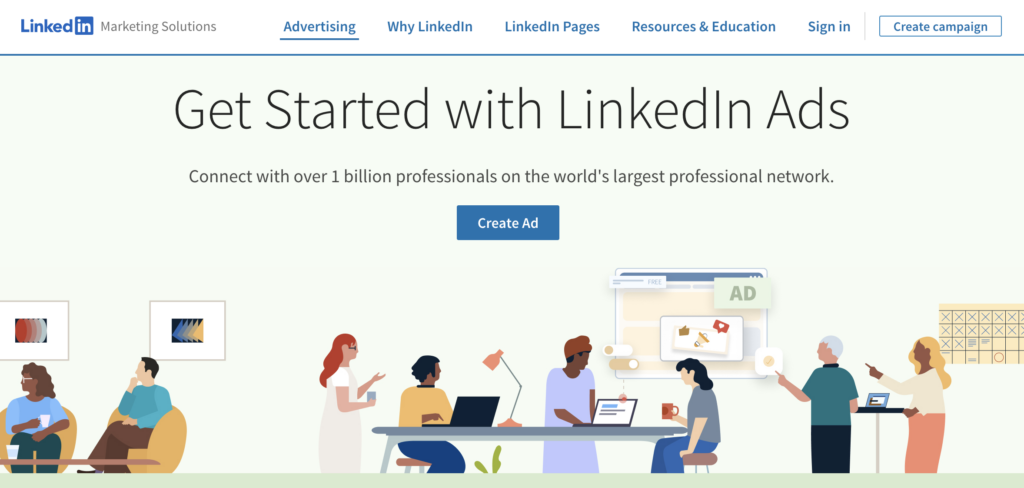
LinkedIn Advertising
There are a lot of options for running paid ads on LinkedIn these days, so if you haven’t logged into the ads portal lately, it can feel overwhelming at first.
When an industrial company is just starting out, it should replicate what it is already doing elsewhere. Therefore, consider starting with text-only ads or running paid traffic to videos that have already done well organically elsewhere.
Start with a small budget and start testing. Run a sponsored update on refreshed industrial market blog content that did well a few years ago and is still relevant. You can also pay to show up in InMail, which is highly effective if you have a niche, targeted market. You can seem omnipresent to a select few for not a lot of ads spend.
“If you have a whole content marketing effort going on and you’re spending a lot of money in creating the videos, and the blogs, and the graphics…why wouldn’t you spend a little bit more to push it to the right people? It’s just like creating a TV commercial and having it just sit on the shelf.”
— Jim Londeree, COO of Dream Factory, (from timestamp 31:15-31:30 in B2B Content Marketing and LinkedIn Advertising in Industrial Product Marketing)
With increased, relevant traffic, you can then see more quickly what is truly working in your industrial marketing strategy to drive the right leads that lead to business growth.
LinkedIn Events
Did you realize there is an events feature built into LinkedIn? One of your most effective calls to action can be to send people to a webinar set up through a LinkedIn Event.
Your audience is already active and engaged there, so keep them on the platform (which makes LinkedIn happy) and sign them up for a purely value-add event hosted by you and your company.
Pro Tips for LinkedIn Events:
- Limit the number of attendees to create real scarcity, increase perceived value, and be able to answer all questions that arise live.
- Keep the webinar short and sweet, targeted on one topic, and just 15-20 minutes long.
- Share the recording as additional content back out to your audience.
- Run paid traffic (in platform via a LinkedIn ad and off via a Google ad) to the recording to get the content in front of your dream clients in your target market.
For all strategies on LinkedIn and B2B marketing, in general, remember to keep a long-play mindset. Don’t go into LinkedIn expecting immediate ROI. You reap what you sow, over time.
Measuring and Analyzing Marketing Efforts
If you focus on the five strategies we covered in this industrial marketing resource guide, you are guaranteed to move the needle for your business.
To review, here are our five favorite strategies for industrial product marketing:
- Account-Based Marketing
- Chat-Based AI
- SEO + PPC
- Content Marketing
- B2B LinkedIn Marketing
After executing your marketing plan, you will be able to learn from better data and be able to make informed decisions on how to iterate. Continue to hone in more and more on what works for you and your niche.
Many business owners and marketers fall into the trap of relying on opinions and personal preferences rather than letting data guide marketing initiatives.
Set up key performance indicators (KPIs) to measurable effectiveness, such as:
- number of new leads generated
- domain authority score
- conversion rates of paid ads
- email open rates
- cost per lead
- video view counts
- lifetime value of an average client
Make sure to use tools like Google Analytics to measure your website's performance, what content is attracting the most traffic, where visitors are coming from, where prospects are ‘bouncing,' and more.
To learn more about other topics in both B2B and consumer marketing, check out TAG's other articles.
Elevate Your Industrial Product Company's Marketing Success
At TAG, we understand the complexities and nuances of standing out in the crowd to stay relevant and grow your business even bigger.
If you want more help with how to market your industrial products company, we can connect you to vetted agencies aligned with your business's unique needs and goals.
Please contact us here at The Agency Guide so we can help, at no cost to you. We're here to support you.
SCHEDULE AN INDUSTRIAL MARKETING CONSULTATION





